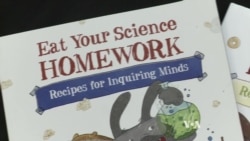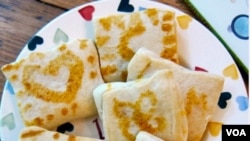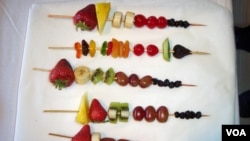Food is a powerful motivator. That’s what Ann McCallum believes. The author and high school teacher, who started her career in an elementary school, says food can help little kids understand abstract concepts. Plus, it's fun to play with. McCallum uses that premise in a series of books, called "Eat Your Homework." She also visits schools, using food to give students a different taste of math and science.
Invisible Ink Snack Pockets
Invisible Ink Snack Pockets
BEFORE YOU BEGIN
Prep time: 10 minutes + cooking time
Yield: 3 servings
INGREDIENTS
• 1 package refrigerated thin-crust pizza dough
• Shredded cheese-mozzarella or cheddar
• Optional add-ins such as ham, mushrooms, green pepper, crumbled bacon, etc.
• ½ teaspoon baking soda
• 1 tablespoon sugar
• Enough water to make a paste (about 2 teaspoons)
METHOD
❶ Ask an adult to preheat the oven to 425° Fahrenheit.
❷ Unroll the dough onto a clean cutting board. Cut rectangular sections about 3 inches by 5 inches.
❸ Spread a generous sprinkling of cheese onto each rectangle. Place the add-ins of your choice on the dough.
❹ Carefully fold over the dough to make a square pocket. Place each pocket on a cookie tray, two inches apart.
❺ Prepare the “invisible ink.” Make a runny paste with the baking soda, sugar, and water. Dip a cotton swab or new paintbrush into the ink and print something on the top of each roll-over snack.
❻ Ask an adult to place the roll-over snacks on the top shelf of the oven for about 5-7 minutes. Then, for 1 to 1 ½ additional minutes, turn the oven on LOW broil. (Watch carefully so they don’t burn!) Remove the snacks as soon as the invisible writing appears.
Bringing Food to Classrooms
At Glenallan Elementary school in Maryland, McCallum is explaining Friedrich Mohs’ Scale of Hardness to a group of eight-year-olds. Two-hundred years ago, the German geologist ranked minerals by their physical characteristics, specifically how hard they are, from the softest, talc, to the hardest element, diamond.
McCallum runs a string across the classroom, and hands out - not minerals, but food items. She has the youngsters line up along the string, based on the firmness of their food. The ones holding marshmallows and cheese gather at one end of the string, while students with onions and apples are the other.
Second grade teacher Zulay Joa can see how her students are benefitting from this experiment.
“It’s a very difficult concept to learn,” she said. “I definitely liked the visualization of the line where they saw ‘1’ as the softest and ‘10’ as the hardest. And right now I’m teaching chemical engineering to 3rd grad and I think that specific lesson will be really a good one to teach students a little bit more about states of the matter.”
Fibonacci Snack Sticks
Fibonacci Snack Sticks
BEFORE YOU BEGIN
Prep time: 15 minutes
Yield: 1-2 sticks per person
INGREDIENTS
You can use any ingredient that can be skewered on a stick. Here are some suggestions:
· Fruit snacks, such as gummy bears
· Whole strawberries
· Miniature marshmallows
· Slices of banana
· Grapes
· Pieces of kiwi
· Maraschino cherries
· Chunks of pineapple
· Raisins
Kebob sticks, the longer the better. These are often made of bamboo or plastic, and can be found in a grocery or kitchen store.
METHOD
❶ Wash and set out to dry on a paper towel all the fruit you will be using for the snack sticks.
❷ Create your edible pattern (1, 1, 2, 3, 5, . . . ). First, skewer one ingredient and push it to the end of the stick.
❸ Spear one different ingredient onto the stick. Slide two, then three, then five food choices onto the stick. If they fit, slide eight more choices onto the stick.
❹ Make 1-2 snack sticks per person. When you share the snack, test your guests to see if they can figure out the rule for the Fibonacci sequence!
'Eat Your Math and Science'
Tying food to math and science is the idea behind two of McCallum’s latest books: "Eat Your Math Homework" and "Eat Your Science Homework."
“Not all the kids can relate to math, not all the kids can relate to science, but they certainly can relate to food,” she explained. “So if we can make that connection, I feel like you can make kids really interested in both math and science.”
Her math recipes are simple, but explain what might be difficult numerical concepts when presented on a chalkboard.
“I’ve got fractions, I’ve got geometry. There is some pre-algebra. There is some sequence pattern,” she said.
Her science recipes cover gravity, atomic particles, inherited traits and - a personal favorite - invisible ink, made of baking soda, sugar and water.
“I had to do quite a few experiments in the kitchen before I found a recipe that you can actually paint onto pizza dough, place it in the oven under the broiler for a minute or two, then, the ink would magically appear," she said.
This recipe, she says, can be used when kids are learning about acids, bases and neutral liquids.
Food Lessons Everywhere
Through workshops, McCallum explains her approach to other teachers. Zulay Joa plans to take some of McCallum’s recipes beyond classrooms, and send them home for her students to do with their parents.
McCallum is now busy writing another book to this series: "Eat Your U.S. History Homework."
“It’s got different elements of the U.S. history,” she said. “So it starts with ‘Thanks for the Succotash’ and it’s the pilgrims landing in Plymouth and the whole story of their introductions with Native Americans who were here and of course there is the recipe of the succotash. So readers will be learning history while they are also making this interesting recipe.”
With studies showing only about 16 percent of U.S. students proficient in science and math, and raising that number is a priority, McCallum hopes her recipes will be a useful tool for teachers and parents, giving young kids a taste for knowledge.








